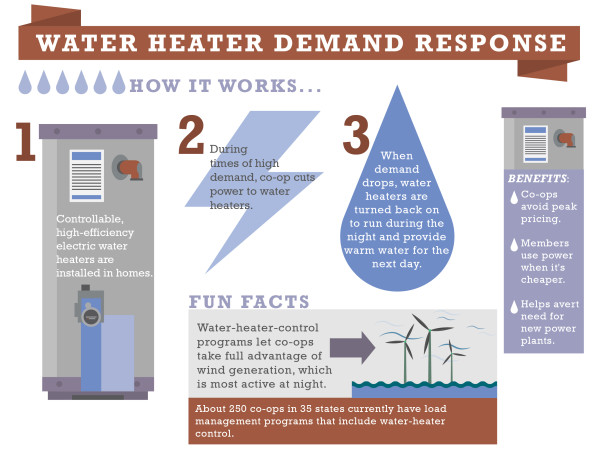 NRECA and a pair of research partners made quite a splash recently with an analysis of the promising energy-storage potential of a humble appliance found in more than 50 million U.S. homes: the electric water heater.
NRECA and a pair of research partners made quite a splash recently with an analysis of the promising energy-storage potential of a humble appliance found in more than 50 million U.S. homes: the electric water heater.
The Hidden Battery: Opportunities in Electric Water Heating details the economic and efficiency prospects of using system-control technology to manage the storage of heat energy, allowing utilities to take heavy load off-line when other demands are high.
Prepared by The Brattle Group, the highly respected Massachusetts-based global consulting and analysis firm, the report was commissioned by NRECA, the Natural Resources Defense Council, the Peak Load Management Alliance, and Great River Energy, a generation and transmission co-op (G&T) based in Maple Grove, Minn.
The findings are not news to many co-op veterans who are long accustomed to shifting loads and shaving peaks.
“Co-ops have been controlling large water heaters for decades in order to reduce demand at peak times, which also reduces members’ electric bills,” says Keith Dennis, NRECA’s senior principal for end-use solutions and standards.
But the new study suggests additional advantages through an emerging idea: “community storage” of wisely used energy. “A community storage program using advanced water heaters allows us to do even more,” Dennis says. “We can store energy, we can optimize the power grid by shaping demand, and we can integrate more renewable resources.”
Community Storage
The 60-page Brattle Group report—packed with comparisons, cost curves, system-operator forecasts, and other analytical details—underscores Dennis’s point. It makes clear that planned, integrated use of existing and soon-to-be-available technologies can turn even everyday appliances into important demand-response resources.
The findings include the possibility of blunting the impacts of future environmental regulations and making fuller use of existing conventional generation sources as well as intermittent renewable ones, all while saving money for both utilities and their consumers.
Great River Energy is a ready-made case study. The G&T has 65,000 water heaters under control through its 28 member distribution systems, allowing it to store a gigawatt-hour of energy every night.
“We believe there’s a battery hidden in basements all across our service territory,” says Gary Connett, Great River Energy’s member services director. “When the wind is blowing or the sun is shining, large-capacity water heaters can be enabled to make immediate use of that energy to heat water to high temperatures. The water heaters can be shut down when renewables are scarce and wholesale costs are high.”
This “hidden battery” concept, Dennis says, is a first step toward community storage of energy, which builds on the increasingly popular idea of community solar, where consumers can buy into utility-scale photovoltaic arrays. It takes that approach further, though, by looking at how the storage capacity of existing devices—electric water heaters, ceramic space heaters, electric vehicles—can be incorporated into an integrated power grid.

Relatively Untapped
When it comes to storage, the Brattle report points out, it makes sense to start with water heaters.
“Electric water heaters are essentially pre-installed thermal batteries that are sitting idle in more than 50 million homes across the U.S.,” the report says. Those heaters account for 9 percent of all U.S. household energy use, behind only air conditioning at 13 percent and lighting at 11 percent. “The magnitude of this relatively untapped resource is significant.”
Some flexibility and cooperation from lawmakers and regulators will be needed before that resource can be tapped, Dennis says in a
Public Utilities Fortnightly article on community storage.
Energy and environmental policies at both the state and federal levels have largely focused on simply reducing kilowatt-hour sales, he writes, when they should be more concerned with using kilowatts the right way when power on the grid is in surplus.
Charging electric vehicles when demand drops overnight, for instance, or warming ceramic bricks in modern space heaters when wind turbines are spinning can be more efficient and cleaner uses of existing resources. The same holds true for timing the operation of water heaters in millions of American homes. “Community storage will be an important tool to make this happen,” Dennis says, adding that “in order for community storage to work, national policy needs to keep up with changes in technology.”
The Brattle Group study compared the performance of common electric-resistance water heaters to air-source heat pump water heaters, both in 50-gallon and 80-gallon sizes, under five control regimens: one focusing on shaving peak demand, another on storing heat, a third on “fast response” to quickly balance loads against available generation, and the fourth and fifth on controlled versus uncontrolled heat pump water heaters.
It modeled the effects of each of these heaters, in each strategy, under supply-and-demand conditions and pricing data for 2014 in the PJM and MISO regional transmission markets. The study also used MISO’s 2028 price and resource forecasts to estimate future impacts of a more integrated approach to energy storage.
“Electric water heaters have the potential to provide significant value to a power grid with a growing need for flexible resources and improved efficiency,” the report states. “The water heating strategies available, including both conventional approaches that have been used for decades and emerging options driven by recent technological advancement, each have their own advantages and beneficial applications.”
The study highlights four top financial benefits:
Generation capacity. “Reductions in water heating load during peak times can avoid or defer the need for new generation capacity to serve growth in system peak demand.”
Transmission and distribution (T&D) facility investments. “Peak load reductions can avoid or defer the need for new T&D investments that are driven specifically by system peak demand growth.”
Energy costs. “Reducing load during high-priced hours leads to a reduction in energy costs.”
Frequency regulation. “Short, frequent increases or decreases in water heating load can provide real-time balancing of supply and demand for electricity.”
Costs of Development
[image-caption title="Using%20energy%20efficient%20water%20heaters%20can%20help%20manage%20demand%20on%20the%20grid,%20and%20shave%20peak%20load." description="(Photo%20courtesy%20Rheem)" image="/remagazine/articles/PublishingImages/Water-Heaters.jpg" /]
The Hidden Battery also factors in some of the marketing, retrofitting, and other costs of deploying a coordinated community storage effort. The report pays close attention to the prospect of “hot water runout” in homes with controlled water heaters.
“It is important to ensure that customers will not run out of hot water due to over-curtailment of load during or immediately preceding the time when customers need hot water,” the report states. “This could lead to low program participation and/or a decrease in customer satisfaction. Therefore, we developed reasonable assumptions about the operational capabilities of these programs that would not violate this constraint.”
One downside of those reasonable assumptions is that the overall proposal’s flexibility becomes limited. While 80-gallon heaters could be safely shut down for up to 16 hours a day, according to the report, the more common 50-gallon household units could only be curtailed for a maximum of four hours a day.
Heating the tank’s water to a higher temperature would boost its efficiency as a thermal battery, but that comes at a cost too. The report includes among its retrofitting and replacement expenses the cost of a mixing valve and adding cooler water to the heater’s output to avoid scalding.
The study also recognizes that coop members, like the customer bases for all types of electric utilities, are a diverse bunch, and some will prefer that their power provider just leave them alone.
“The peak shaving strategy is likely best suited for situations where customers require the most minimally intrusive program or otherwise have a very high sensitivity to the possibility of a hot water shortage.”
Because consumers will have differing priorities when choosing water heaters—or when electing to join a water heater control program—the report recommends that utilities adopt a range of programs to boost participation.
“Customer preferences for different water heating program options will vary,” the study says. “System-level benefits are likely to be greatest when programs are offered as a portfolio. A portfolio is effectively a diversified product offering that will maximize participation.”
Increased participation, in turn, will maximize the environmental benefits of community energy storage. In addition to allowing utilities to balance loads with the availability of solar and wind resources, the report says, electric water heater storage could yield reductions in power plant carbon dioxide emissions.
Beneficial Electrification
The report acknowledges that it’s a bit of a mixed bag.
“Across all scenarios analyzed, heat pump water heaters provide consistent CO2 [carbon dioxide] emissions reductions per customer,” it states. “The efficiency improvement of heat pump water heaters results in a proportional reduction in emissions due to the around-the-clock nature of the energy savings. With electric resistance water heaters, the story is more nuanced.”
Even so, it finds “in a scenario with coal and natural gas on the margin but with environmentally oriented curtailment of the water heater, CO2 emissions from water heating load could be reduced by roughly 29 percent.”
And taking community storage beyond the water heater brings even greater environmental benefits, Dennis notes in his
Public Utilities Fortnightly article. Charging electric vehicle batteries with overnight, off-peak power, he says, would go a long way toward curbing greenhouse gas emissions.
The goal, as Dennis defines it, is “beneficial electrification.”
“Many experts agree that meeting greenhouse gas and other climate goals will require aggressively electrifying both the transportation and end-use space and water heating sectors,” he says. “If we do not align policy to encourage beneficial electrification, we are missing opportunities to better achieve our environmental goals.”
[panel title="Community%20Storage%20Gives%20Co-ops%20Flexibility" link-text="Read%20More" link="/remagazine/articles/Pages/Community-Storage-Gives-Co-ops-Flexibility.aspx"]Energy storage—the holy grail of the electric power industry—that will save consumers money and give electric cooperatives new flexibility might be as close as your water heater. [/panel]
